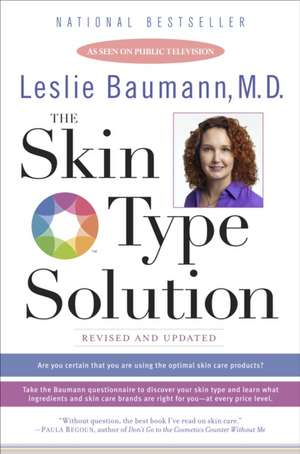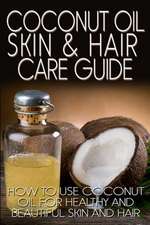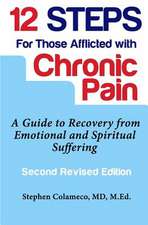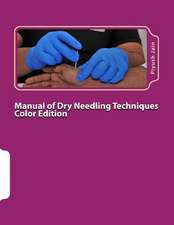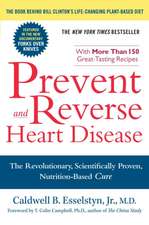The Skin Type Solution
Autor LESLIE BAUMANNen Limba Engleză Paperback – 30 noi 2006
Vezi toate premiile Carte premiată
Books for a Better Life (2006)
FORGET EVERYTHING YOU THOUGHT YOU KNEW ABOUT WHAT’S GOOD FOR YOUR SKIN—AND LEARN THE TRUTH.
Take the simple questionnaire inside this book and within minutes discover which of the sixteen unique skin types describes your skin, which ingredients to avoid, the skin care brands that are right for you, and your new time- and money-saving regimen. In this revised edition of her classic bestseller, world-renowned Miami Beach dermatologist and researcher Dr. Leslie Baumann helps you shop for the optimal skin care products. She provides detailed lists of recommended products suited to every skin type and budget. Inside you’ll find
• your personal skin type profile detailing exactly what will work—and what won’t—for your unique complexion
• the newest products for healthy, radiant skin—cleansers, moisturizers, toners, sun blocks, foundations, and more
• tips on preventing skin aging and “problem” skin
• vital information on the new world of prescription products, facials, chemical peels, Retin-A, Botox, and Restylane injections
Now you can look like a million bucks without spending a fortune. This book is almost as good as having Dr. Baumann give you a personal consultation!
Preț: 117.05 lei
Nou
Puncte Express: 176
Preț estimativ în valută:
22.40€ • 23.45$ • 18.53£
22.40€ • 23.45$ • 18.53£
Carte disponibilă
Livrare economică 15-29 martie
Preluare comenzi: 021 569.72.76
Specificații
ISBN-13: 9780553383300
ISBN-10: 0553383302
Pagini: 337
Dimensiuni: 160 x 233 x 20 mm
Greutate: 0.35 kg
Editura: Bantam Books
Locul publicării:New York, NY
ISBN-10: 0553383302
Pagini: 337
Dimensiuni: 160 x 233 x 20 mm
Greutate: 0.35 kg
Editura: Bantam Books
Locul publicării:New York, NY
Notă biografică
Leslie Baumann, M.D., founded the University of Miami Cosmetic Medicine and Research Institute in 1997, the first university-run research center dedicated to cosmetic dermatology and skin care. Her revolutionary skin typing system has been adopted worldwide. She is also the author of the bestselling textbook Cosmetic Dermatology and is a regular contributor to Yahoo! Health.
Extras
Chapter One
Why Skin Typing?
Introduction
How many times have you gone to a cosmetic counter and spent $50 to $150 on products you never again use? Has a saleswoman or cosmetologist sold you a line that “did wonders for me,” but does nothing for you? Have you developed an allergy or irritation to a product without knowing them cause? Why does your best friend swear by a facial care product that makes your skin look and feel terrible? Should you or shouldn’t you use soap? Why do you hate the feel of sunscreen, though you know you should use it? Is a chemical face peel right for you? Should you consider using Retin-A? If you owned a Subaru Forester, you wouldn’t follow the maintenance procedures for a Volkswagen Golf. So if you happen to have dry, sensitive skin, why on earth would you use a moisturizer, cleanser, and cosmetic procedure
more suited to someone with oily, resistant skin?
The reason? You don’t know what type of skin you have; therefore, you don’t know how to care for your skin. Until the publication of The Skin Type Solution, the Baumann Skin Typing System was not widely known or available. While many people have a general understanding of their skin, most have relied on commonly known but imprecise, unscientific definitions that fall short of providing a true and complete picture.
My many years as a dermatologist, researcher, and professor of dermatology have convinced me that no one ever needs to have a “bad skin day.”
Knowing your Skin Type is the missing, essential step to finding your way to beneficial products and treatments–and beautiful skin. But if you’re like the typical first-time patient at my bustling University of Miami clinic, I’ll bet you:
·Don’t know your Skin Type
·Don’t know that it’s essential to base skin care decisions on your Skin Type
·Use the wrong products for your Skin Type
·Spend much more than you should on those products
·Use the wrong procedures for your Skin Type
·Fail to take advantage of procedures that would benefit your Skin Type
When it comes to using skin care products and services, most people have been in the Dark Ages, wandering through a maze of product misinformation and overzealous marketing, lucky to stumble on anything that works. To properly care for your skin and prevent aging, you need a treatment model that describes and captures the very real and scientifically verifiable distinctions in skin physiology.
Skin Typing does just that.
Plus, you need a concrete program specifically and individually tailored to the unique attributes of your Skin Type. The Skin Type Solution provides all of that vital information and guidance.
Once you’ve discovered your Skin Type (through answering a questionnaire in Chapter Three), you can go straight to the chapter on your Skin Type and find everything you need right there. There is a science to skin care, and once you know your Skin Type, it all gets a lot easier.
I’ve spent the last ten years defining and clinically testing my Skin Type solutions on thousands of patients at my University of Miami clinic to assure that my scientific criteria will work for everyone, of every skin color, ethnicity, age, and sex. And it does.
Perhaps you’ve already benefited from understanding your psychological type, your learning style, or your Ayurvedic type. If so, you’ll appreciate how critical it is to get a handle on your Skin Type. This understanding lets you take control of your skin.
My Special Expertise
The guidance and gems I’ll give you won’t appear anywhere else. I launched, and currently direct, the University of Miami Cosmetic Center, the first university-run cosmetic research center in the United States, where I treat thousands of patients every year. In addition to being an MD, I am a professor at the University of Miami and the chief of the Division of Cosmetic Dermatology, making me the first cosmetic dermatologist in the United States dedicated to the field of cosmetic dermatology who is also a full-time university faculty member, teaching and conducting research.
This unprecedented combination affords me a unique position. My academic responsibilities keep me right on the cutting edge of research, while my clinical work has been a proving ground for refining the recommendations that arise from my findings.
My clients–who range from gorgeous fashion models to topflight professionals, to fellow physicians, to all kinds of men and women concerned about aging–have reaped the benefits of my unique understanding of the role of Skin Type in skin care.
As a scientist who is also a woman who loves to experiment with beauty and skin care products and routines, I’m tireless in seeking out and researching all beauty options because I use them myself. What’s more, as a person who wants to look my best all my life, I can put myself in your shoes and figure out how to best serve your skin care needs.
Defining a New Typology
Up until now, the field of dermatology lacked a rational model that people could learn to follow and apply for themselves. Prior to Skin Typing, the preexisting mode of analyzing skin differences dated back to the early 1900s, when cosmetic giant Helena Rubenstein first divided skin into four categories: normal, combination, dry, and sensitive. While that was revolutionary for its time, today we can apply more accurate scientific criteria to the range of skin differences.
Before Skin Typing, even dermatologists felt frustrated, since we all want to understand skin better and offer our patients tailor-made solutions. But until now, the revolutionary classification of the sixteen Skin Types was not there to help.
Here’s just one example of the kind of confusion that runs rampant, even among professionals. I recently was on the advisory board of a major company with two prominent dermatologists. One was an “R” (someone with resistant, nonreactive skin) and the other one was an “S” (someone with sensitive skin). Right there in front of the company president, the two had a huge argument, with the “R” dermatologist claiming that there was no difference in skin care products and that it was all marketing hype. She could use anything on her facial skin, she told us, even Ivory soap, without a problem. The “S” skin dermatologist was shocked. Almost everything made her skin turn red and sting, she retorted. These two skin professionals did not understand that their opposing points of view stemmed from their opposite Skin Types. I saw very clearly that something was missing and wanted to simplify skin care, once and for all.
As a clinician, I’d seen the damage caused by following an inappropriate skin care routine. As a caring doctor, I’d heard the frustration and confusion of people trying to make good skin care choices while barraged by a plethora of products and overwhelmed by conflicting and often misleading marketing claims. Because each person had particular skin care needs, I noticed that the same products did not work for everyone, so I tailored individualized skin care regimens for my clients. Over time a clear, consistent, and replicable typology emerged. The sixteen Skin Types are the keys to a complete diagnostic and treatment program that covers every significant skin factor and that really works.
My system measures four factors in skin: oiliness vs. dryness, resistance vs. sensitivity, pigmentation vs. non-pigmentation, and tightness vs. wrinkling. Determining where you fall in each of the four categories serves as the foundation for typing your skin. Your Skin Type is more than the sum of the four different factors. Their interplay and expression are unique for each type. After seeing literally thousands of patients and refining the Baumann Skin Type Questionnaire over the last ten years, I can assure you that Skin Typing captures each Skin Type’s unique qualities and shows you how to work with your type’s strengths and weaknesses.
Once you understand your Skin Type, proper skin care isn’t complicated or costly. You won’t need to use a shelfful of products. Honing in on what your skin needs will actually simplify your beauty routine, making it easier to follow and more economical. Following the advice I’ll extend in your Skin Type’s chapter will end “bad skin days” because it will end bad skin care decisions.
How to Use This Book
In reading the opening chapter of this book, you’ll familiarize yourself with the underlying principles of Skin Typing. In Chapter Two, you’ll learn my innovative vocabulary to help you understand the different factors that I take into account when determining your Skin Type. In Chapter Three, you’ll take the Baumann Skin Type Questionnaire. Once you tabulate your results, you will know exactly which one of the sixteen types describes your skin. You can then turn directly to that chapter for a complete profile that will provide you with everything you need to take charge of your skin and give it the best possible care. The bottom line is that by reading your chapter, you will get to know your skin. This will provide the foundation for following my subsequent advice.
Each chapter contains Daily Skin Care Regimens specifically designed to address your Skin Type’s problem areas. To follow your type’s regimen, you will need to use the kinds of products I recommend. I’ll provide a list of suggestions for each type of product, as well as extra suggestions to use when you have specific skin problems.
If you currently use products that you find effective, you can also continue to use them, if you wish. However, if you decide to do that, I advise you to consult the lists of ingredients that define which ones are favorable or counterproductive for your Skin Type. Some ingredients may be helpful for one of your skin concerns, but exacerbate another skin problem. For example, genistein, a component found in soy, helps wrinkles, but also increases pigmentation. A Non-Pigmented, Wrinkled Skin Type could safely use it, but a Pigmented, Wrinkled Type should only use products that contain soy that has had the genistein removed. That’s one reason why I advise that you double-check your current products to ensure that they do not contain any no-nos. If they do, I recommend that you change products, as you could be unwittingly causing a problem. And you may also find that some of your favorite products do indeed contain helpful ingredients for your type. Still, I can best guarantee results with the products I know and recommend.
This book should be your companion when you shop for skin care products. As you put my recommendations in place, monitor how well they are working for you to assess whether or not consulting a dermatologist would be of benefit. For some Skin Types, I provide one or more additional Stage Two Daily Skin Care Regimens which address treating special skin problems. Near the end of each chapter, I will point you toward your best options in cosmetic dermatology.
In the chapter on your Skin Type, you will find:
1. Understanding of:
a. The basic qualities of your Skin Type
b. Your Skin Type’s issues and challenges
c. Risk factors associated with your Skin Type
2. Guidelines for:
a. Your Skin Type’s Daily Skin Care Regimen
b. Sun protection for your skin
c. Makeup that will help improve your skin condition
d. Cosmetic procedures that can help your skin (where applicable)
e. Cosmetic procedures that are not recommended for you (where
applicable)
3. Specific Recommendations for:
a. Skin care products for your daily skin care routine
b. Skin care ingredients (to look for on product labels) that address your key
skin issues
c. Skin care ingredients (to look for on product labels) that you should
avoid because they can worsen your skin
My role in research and industry development gives me an unparalleled across-the-board knowledge of skin care ingredients. I’ll indicate the best way to cleanse your skin, reveal whether you need to use a toner or a moisturizer, diagnose whether exfoliation is advisable for you, and advise you when you’d benefit from prescription skin medications. All of my product recommendations will include options at low, medium, and high prices so that whatever your budget, you can follow my recommendations to successful skin care. All selections are widely available, so you’ll have no trouble obtaining them.
Your Skin Type chapter will also help you to avoid products and procedures that–while recommended for other types–are either useless or potentially harmful for you. If you are curious about a cosmetic procedure, like Botox, your chapter will indicate whether, based on your Skin Type, it’s something that you and your dermatologist should consider. That way you can make sure you choose the skin procedures most beneficial for your skin’s
particular needs.
When to Consult a Dermatologist
In addition to guiding you through the product maze, I will help you decide when to consult a dermatologist. Some types have very little need to see a doctor, while certain others really benefit from the prescription medications, light treatments, and other procedures doctors can provide. In fact, for certain Skin Types with increased skin issues, nonprescription products may not be sufficiently effective. People with highly resistant skin, for example, need higher-octane products, which only licensed physicians can prescribe.
Due to a national shortage of qualified dermatologists, people wait an average of three months to get an appointment. As a result, most dermatologists cannot always spend the time necessary to address basic skin care needs. By teaching you how to meet your basic skin care needs without a dermatologist, I’ll ensure you make efficient use of your valuable appointment time when you see a doctor.
Finally, I have launched a Web site, www.16skintypes.com, to track your responses to different products, so now you can join the patients who see me at my clinic in offering your feedback and experiences while following the Baumann Skin Type Solution. Log on to www.16skintypes.com and share your skin care discoveries with me and other people from around the world who share your Skin Type. Find out what’s new and ask specific questions about your skin concerns.
What You Need to Know About Skin Care Products
For you as a consumer in the billion-dollar skin care industry, lack of information about products is costly, and you have to bridge the gap between what you know and what you need to know. Without accurate information, you are throwing your money away, because you are completely at the mercy of advertisers and marketers. With the specific information about your skin’s needs explained in this book, you can take control of your skin. This book will save you the expense, trouble, and waste of buying the wrong products–while directing you to the right ones. My recommendations are ingredient driven, and once you’ve learned my criteria, you too will be better able to read a cosmetic label and figure out if it’s appropriate for you.
I have tried to incorporate into this book every kind of skin care product that I feel is useful, limiting the scope to facial care products. I have chosen the products recommended in this book based on their ingredients, manufacturing practices, and formulations.
Instead of letting you waste your valuable time and money tracking down products that wind up in the trash, I will direct you to ones that will really help. I’ve reviewed the clinical trial data for the products, when available, to offer those proven effective. Finally, since my patients have used my recommendations, I’ve listened to their feedback and tracked their treatment results to guarantee the efficacy of the treatment approach and product selection for each Skin Type. All you have to do is take the test, determine your Skin Type, and choose from the products in your chapter. And at least when you splurge on products and procedures, you’ll know you are getting your money’s worth.
The recommendations are independent of any relationships that I have with the companies that manufacture them. Of course, when I work with a company, I know more about its products. However, I work with over thirty-seven companies and have approached many others for information while writing this book. In addition, when I find products with helpful ingredients from other sources, like stores or the Internet, I test them as well. After all, I test skin care products for a living–so why not?
All the products that I recommend:
1. Contain the right ingredients for your Skin Type
2. Contain sufficient amounts of active ingredients to be effective
3. Do not contain counterproductive ingredients
4. Are formulated effectively for your needs
5. Are packaged to maintain stability of the active ingredients
6. Are cosmetically elegant (smell good and feel good)
7. Got a thumbs-up from those who’ve used them
8. Are easily available for purchase
Finally, since all products meet all of the above criteria, I often pick the cheapest option (or a hands-down favorite) as a Baumann’s Choice. This designates the best value to make your product selections easier.
Skin Typing Is Universal
One of the fascinating features of Skin Typing is that people of different ethnic or racial backgrounds can share a Skin Type. In most instances, all people with the same Skin Type will follow the exact same treatment plan, but sometimes skin color can be a differentiating factor because of the way pigment (the factor in skin that produces color) is produced in different racial and ethnic groups. For example, two best friends, Valerie, a medium—skintoned brunette, and Dana, a dark-skinned woman, came in for back-toback appointments. After they each took the questionnaire and tabulated their results, they were surprised to discover that they shared the same Skin Type. They were both “P,” Pigmented Skin Types, which gave both Valerie and Dana a tendency to develop pigmentation issues. And each of them did have a problem with pigmentation. That’s why they came to my office.
Valerie had an area of dark skin discoloration (called melasma) on her cheek, and Dana had dark spots in areas where she had once had pimples. Although I recommended that they follow the exact same protocol and use the same kinds of products, there was one key difference. Valerie could benefit from an advanced cosmetic procedure that uses light instruments or lasers to treat pigment problems like hers, while Dana would benefit most from prescription products used daily and should not undergo laser treatment since this can cause discoloration in people with darker skin tones.
That’s why, throughout the book whenever an adjustment based on skin color is needed, I’ll fine-tune recommendations so that you will know how to adapt them to your needs whether you have a light, medium, or dark skin tone.
Skin Care Myths
When people come into my office, I regularly have to deprogram them of skin care dis-information. For example, do you buy into any of these common beauty myths?
Myth # 1: The way to find the right skin care product is by buying lots of different
products until you find one that works for you (if you’re lucky).
Actually, this approach works well for the cosmetics industry, but it’s not so good for you–unless you happen to have loads of money, tons of free time, and a desire to experiment on your skin. Yet, that’s the way most people purchase skin care products and services. Without knowing your Skin Type and being directed to the range of products that work well for it, you are at the mercy of marketers and advertisers.
In this book, I will demystify skin products, and let you know what’s worthwhile, or worthless, for your Skin Type’s needs–and why. Because of the way that they are regulated by the FDA, cosmetic companies cannot lay claim to any biological activity. If they did, their products would be regulated as drugs, with costly clinical trials needed to validate their claims. Instead they make vague marketing statements. No wonder people are confused. However, as a dermatologist, I can reveal the biological effects of different products to cut through the hype.
Myth #2: The more expensive a product, the better it will work.
What does the high price tag on that designer skin cream buy you? Not the ingredients in the bottle. Instead, most often you are footing the bill for the marketing and bottling of that product. In fact, if tomorrow someone invented the world’s best skin cream, they could sell the rights to market it to different segments of the skin care marketplace, and very likely the only difference between the drugstore item, the department store brandname version, and the special edition sold by dermatologists would be, you guessed it, the packaging and price. However, the creams contained therein could well be absolutely identical. Some day I’d love to see high-end lines that are really worth the extra expense because they are packed with ingredients that can deliver real results. In this book, you’ll learn what products work well for your Skin Type’s unique needs, without busting your budget.
Myth #3: Ivory soap is for sensitive skin.
Any product that vigorously suds and foams contains detergent, a strict no-no for dry skin. The best-known example is Ivory soap, marketed with the buzz phrase “so pure it floats.” Advertising featured pictures of delicate babies and fair-skinned blondes, along with the recommendation that since it was “pure, and fragrance free,” it was designed “for sensitive skin.” Nothing could be further from the truth. Vigorously foaming soaps, like Ivory, are terrible for dry skin because they wash away the natural lipids that help your skin retain moisture. If you have dry skin, never use anything that makes a lot of bubbles, especially bubble bath. Thin foam and thin bubbles are all right. Never wash your face with shampoo no matter what your Skin Type. Instead use non-foaming cleansers or minimally foaming cleansers like Cetaphil, Dove, Pond’s, or certain Nivea products.
Myth #4: The food I eat won’t affect my skin.
Your diet does impact your skin, and there’s no doubt that going on a no- or low-fat diet can increase skin dryness. Studies have shown that patients on cholesterol-lowering drugs often suffer from dry skin. Cholesterol is actually an important part of the skin that helps it remain hydrated.
Myth #5: Paying attention to my skin is a waste of time.
If you have one of the easier Skin Types, your recommended routine is not going to create unnecessary complexity. What’s more, fine-tuning your skin care can only save you money and optimize your skin in the long run. On the other hand, if you have a challenging Skin Type, treating your skin right and preventing future problems is an absolute essential. Most skin problems are better addressed sooner rather than later. And whatever your age, skin condition, or Skin Type, sooner is today.
Ready, Set . . . Skin Type!
I’m truly delighted to be able to share with you my discoveries and to help you manage your skin and treat it right. Try the regimens and products, and see how they work for you. Don’t hesitate to see a dermatologist if you need to, as there are many advanced medications and procedures of real benefit. Finally, share Skin Typing with your friends, family, and loved ones because there’s a Skin Type Solution for everyone.
From the Hardcover edition.
Why Skin Typing?
Introduction
How many times have you gone to a cosmetic counter and spent $50 to $150 on products you never again use? Has a saleswoman or cosmetologist sold you a line that “did wonders for me,” but does nothing for you? Have you developed an allergy or irritation to a product without knowing them cause? Why does your best friend swear by a facial care product that makes your skin look and feel terrible? Should you or shouldn’t you use soap? Why do you hate the feel of sunscreen, though you know you should use it? Is a chemical face peel right for you? Should you consider using Retin-A? If you owned a Subaru Forester, you wouldn’t follow the maintenance procedures for a Volkswagen Golf. So if you happen to have dry, sensitive skin, why on earth would you use a moisturizer, cleanser, and cosmetic procedure
more suited to someone with oily, resistant skin?
The reason? You don’t know what type of skin you have; therefore, you don’t know how to care for your skin. Until the publication of The Skin Type Solution, the Baumann Skin Typing System was not widely known or available. While many people have a general understanding of their skin, most have relied on commonly known but imprecise, unscientific definitions that fall short of providing a true and complete picture.
My many years as a dermatologist, researcher, and professor of dermatology have convinced me that no one ever needs to have a “bad skin day.”
Knowing your Skin Type is the missing, essential step to finding your way to beneficial products and treatments–and beautiful skin. But if you’re like the typical first-time patient at my bustling University of Miami clinic, I’ll bet you:
·Don’t know your Skin Type
·Don’t know that it’s essential to base skin care decisions on your Skin Type
·Use the wrong products for your Skin Type
·Spend much more than you should on those products
·Use the wrong procedures for your Skin Type
·Fail to take advantage of procedures that would benefit your Skin Type
When it comes to using skin care products and services, most people have been in the Dark Ages, wandering through a maze of product misinformation and overzealous marketing, lucky to stumble on anything that works. To properly care for your skin and prevent aging, you need a treatment model that describes and captures the very real and scientifically verifiable distinctions in skin physiology.
Skin Typing does just that.
Plus, you need a concrete program specifically and individually tailored to the unique attributes of your Skin Type. The Skin Type Solution provides all of that vital information and guidance.
Once you’ve discovered your Skin Type (through answering a questionnaire in Chapter Three), you can go straight to the chapter on your Skin Type and find everything you need right there. There is a science to skin care, and once you know your Skin Type, it all gets a lot easier.
I’ve spent the last ten years defining and clinically testing my Skin Type solutions on thousands of patients at my University of Miami clinic to assure that my scientific criteria will work for everyone, of every skin color, ethnicity, age, and sex. And it does.
Perhaps you’ve already benefited from understanding your psychological type, your learning style, or your Ayurvedic type. If so, you’ll appreciate how critical it is to get a handle on your Skin Type. This understanding lets you take control of your skin.
My Special Expertise
The guidance and gems I’ll give you won’t appear anywhere else. I launched, and currently direct, the University of Miami Cosmetic Center, the first university-run cosmetic research center in the United States, where I treat thousands of patients every year. In addition to being an MD, I am a professor at the University of Miami and the chief of the Division of Cosmetic Dermatology, making me the first cosmetic dermatologist in the United States dedicated to the field of cosmetic dermatology who is also a full-time university faculty member, teaching and conducting research.
This unprecedented combination affords me a unique position. My academic responsibilities keep me right on the cutting edge of research, while my clinical work has been a proving ground for refining the recommendations that arise from my findings.
My clients–who range from gorgeous fashion models to topflight professionals, to fellow physicians, to all kinds of men and women concerned about aging–have reaped the benefits of my unique understanding of the role of Skin Type in skin care.
As a scientist who is also a woman who loves to experiment with beauty and skin care products and routines, I’m tireless in seeking out and researching all beauty options because I use them myself. What’s more, as a person who wants to look my best all my life, I can put myself in your shoes and figure out how to best serve your skin care needs.
Defining a New Typology
Up until now, the field of dermatology lacked a rational model that people could learn to follow and apply for themselves. Prior to Skin Typing, the preexisting mode of analyzing skin differences dated back to the early 1900s, when cosmetic giant Helena Rubenstein first divided skin into four categories: normal, combination, dry, and sensitive. While that was revolutionary for its time, today we can apply more accurate scientific criteria to the range of skin differences.
Before Skin Typing, even dermatologists felt frustrated, since we all want to understand skin better and offer our patients tailor-made solutions. But until now, the revolutionary classification of the sixteen Skin Types was not there to help.
Here’s just one example of the kind of confusion that runs rampant, even among professionals. I recently was on the advisory board of a major company with two prominent dermatologists. One was an “R” (someone with resistant, nonreactive skin) and the other one was an “S” (someone with sensitive skin). Right there in front of the company president, the two had a huge argument, with the “R” dermatologist claiming that there was no difference in skin care products and that it was all marketing hype. She could use anything on her facial skin, she told us, even Ivory soap, without a problem. The “S” skin dermatologist was shocked. Almost everything made her skin turn red and sting, she retorted. These two skin professionals did not understand that their opposing points of view stemmed from their opposite Skin Types. I saw very clearly that something was missing and wanted to simplify skin care, once and for all.
As a clinician, I’d seen the damage caused by following an inappropriate skin care routine. As a caring doctor, I’d heard the frustration and confusion of people trying to make good skin care choices while barraged by a plethora of products and overwhelmed by conflicting and often misleading marketing claims. Because each person had particular skin care needs, I noticed that the same products did not work for everyone, so I tailored individualized skin care regimens for my clients. Over time a clear, consistent, and replicable typology emerged. The sixteen Skin Types are the keys to a complete diagnostic and treatment program that covers every significant skin factor and that really works.
My system measures four factors in skin: oiliness vs. dryness, resistance vs. sensitivity, pigmentation vs. non-pigmentation, and tightness vs. wrinkling. Determining where you fall in each of the four categories serves as the foundation for typing your skin. Your Skin Type is more than the sum of the four different factors. Their interplay and expression are unique for each type. After seeing literally thousands of patients and refining the Baumann Skin Type Questionnaire over the last ten years, I can assure you that Skin Typing captures each Skin Type’s unique qualities and shows you how to work with your type’s strengths and weaknesses.
Once you understand your Skin Type, proper skin care isn’t complicated or costly. You won’t need to use a shelfful of products. Honing in on what your skin needs will actually simplify your beauty routine, making it easier to follow and more economical. Following the advice I’ll extend in your Skin Type’s chapter will end “bad skin days” because it will end bad skin care decisions.
How to Use This Book
In reading the opening chapter of this book, you’ll familiarize yourself with the underlying principles of Skin Typing. In Chapter Two, you’ll learn my innovative vocabulary to help you understand the different factors that I take into account when determining your Skin Type. In Chapter Three, you’ll take the Baumann Skin Type Questionnaire. Once you tabulate your results, you will know exactly which one of the sixteen types describes your skin. You can then turn directly to that chapter for a complete profile that will provide you with everything you need to take charge of your skin and give it the best possible care. The bottom line is that by reading your chapter, you will get to know your skin. This will provide the foundation for following my subsequent advice.
Each chapter contains Daily Skin Care Regimens specifically designed to address your Skin Type’s problem areas. To follow your type’s regimen, you will need to use the kinds of products I recommend. I’ll provide a list of suggestions for each type of product, as well as extra suggestions to use when you have specific skin problems.
If you currently use products that you find effective, you can also continue to use them, if you wish. However, if you decide to do that, I advise you to consult the lists of ingredients that define which ones are favorable or counterproductive for your Skin Type. Some ingredients may be helpful for one of your skin concerns, but exacerbate another skin problem. For example, genistein, a component found in soy, helps wrinkles, but also increases pigmentation. A Non-Pigmented, Wrinkled Skin Type could safely use it, but a Pigmented, Wrinkled Type should only use products that contain soy that has had the genistein removed. That’s one reason why I advise that you double-check your current products to ensure that they do not contain any no-nos. If they do, I recommend that you change products, as you could be unwittingly causing a problem. And you may also find that some of your favorite products do indeed contain helpful ingredients for your type. Still, I can best guarantee results with the products I know and recommend.
This book should be your companion when you shop for skin care products. As you put my recommendations in place, monitor how well they are working for you to assess whether or not consulting a dermatologist would be of benefit. For some Skin Types, I provide one or more additional Stage Two Daily Skin Care Regimens which address treating special skin problems. Near the end of each chapter, I will point you toward your best options in cosmetic dermatology.
In the chapter on your Skin Type, you will find:
1. Understanding of:
a. The basic qualities of your Skin Type
b. Your Skin Type’s issues and challenges
c. Risk factors associated with your Skin Type
2. Guidelines for:
a. Your Skin Type’s Daily Skin Care Regimen
b. Sun protection for your skin
c. Makeup that will help improve your skin condition
d. Cosmetic procedures that can help your skin (where applicable)
e. Cosmetic procedures that are not recommended for you (where
applicable)
3. Specific Recommendations for:
a. Skin care products for your daily skin care routine
b. Skin care ingredients (to look for on product labels) that address your key
skin issues
c. Skin care ingredients (to look for on product labels) that you should
avoid because they can worsen your skin
My role in research and industry development gives me an unparalleled across-the-board knowledge of skin care ingredients. I’ll indicate the best way to cleanse your skin, reveal whether you need to use a toner or a moisturizer, diagnose whether exfoliation is advisable for you, and advise you when you’d benefit from prescription skin medications. All of my product recommendations will include options at low, medium, and high prices so that whatever your budget, you can follow my recommendations to successful skin care. All selections are widely available, so you’ll have no trouble obtaining them.
Your Skin Type chapter will also help you to avoid products and procedures that–while recommended for other types–are either useless or potentially harmful for you. If you are curious about a cosmetic procedure, like Botox, your chapter will indicate whether, based on your Skin Type, it’s something that you and your dermatologist should consider. That way you can make sure you choose the skin procedures most beneficial for your skin’s
particular needs.
When to Consult a Dermatologist
In addition to guiding you through the product maze, I will help you decide when to consult a dermatologist. Some types have very little need to see a doctor, while certain others really benefit from the prescription medications, light treatments, and other procedures doctors can provide. In fact, for certain Skin Types with increased skin issues, nonprescription products may not be sufficiently effective. People with highly resistant skin, for example, need higher-octane products, which only licensed physicians can prescribe.
Due to a national shortage of qualified dermatologists, people wait an average of three months to get an appointment. As a result, most dermatologists cannot always spend the time necessary to address basic skin care needs. By teaching you how to meet your basic skin care needs without a dermatologist, I’ll ensure you make efficient use of your valuable appointment time when you see a doctor.
Finally, I have launched a Web site, www.16skintypes.com, to track your responses to different products, so now you can join the patients who see me at my clinic in offering your feedback and experiences while following the Baumann Skin Type Solution. Log on to www.16skintypes.com and share your skin care discoveries with me and other people from around the world who share your Skin Type. Find out what’s new and ask specific questions about your skin concerns.
What You Need to Know About Skin Care Products
For you as a consumer in the billion-dollar skin care industry, lack of information about products is costly, and you have to bridge the gap between what you know and what you need to know. Without accurate information, you are throwing your money away, because you are completely at the mercy of advertisers and marketers. With the specific information about your skin’s needs explained in this book, you can take control of your skin. This book will save you the expense, trouble, and waste of buying the wrong products–while directing you to the right ones. My recommendations are ingredient driven, and once you’ve learned my criteria, you too will be better able to read a cosmetic label and figure out if it’s appropriate for you.
I have tried to incorporate into this book every kind of skin care product that I feel is useful, limiting the scope to facial care products. I have chosen the products recommended in this book based on their ingredients, manufacturing practices, and formulations.
Instead of letting you waste your valuable time and money tracking down products that wind up in the trash, I will direct you to ones that will really help. I’ve reviewed the clinical trial data for the products, when available, to offer those proven effective. Finally, since my patients have used my recommendations, I’ve listened to their feedback and tracked their treatment results to guarantee the efficacy of the treatment approach and product selection for each Skin Type. All you have to do is take the test, determine your Skin Type, and choose from the products in your chapter. And at least when you splurge on products and procedures, you’ll know you are getting your money’s worth.
The recommendations are independent of any relationships that I have with the companies that manufacture them. Of course, when I work with a company, I know more about its products. However, I work with over thirty-seven companies and have approached many others for information while writing this book. In addition, when I find products with helpful ingredients from other sources, like stores or the Internet, I test them as well. After all, I test skin care products for a living–so why not?
All the products that I recommend:
1. Contain the right ingredients for your Skin Type
2. Contain sufficient amounts of active ingredients to be effective
3. Do not contain counterproductive ingredients
4. Are formulated effectively for your needs
5. Are packaged to maintain stability of the active ingredients
6. Are cosmetically elegant (smell good and feel good)
7. Got a thumbs-up from those who’ve used them
8. Are easily available for purchase
Finally, since all products meet all of the above criteria, I often pick the cheapest option (or a hands-down favorite) as a Baumann’s Choice. This designates the best value to make your product selections easier.
Skin Typing Is Universal
One of the fascinating features of Skin Typing is that people of different ethnic or racial backgrounds can share a Skin Type. In most instances, all people with the same Skin Type will follow the exact same treatment plan, but sometimes skin color can be a differentiating factor because of the way pigment (the factor in skin that produces color) is produced in different racial and ethnic groups. For example, two best friends, Valerie, a medium—skintoned brunette, and Dana, a dark-skinned woman, came in for back-toback appointments. After they each took the questionnaire and tabulated their results, they were surprised to discover that they shared the same Skin Type. They were both “P,” Pigmented Skin Types, which gave both Valerie and Dana a tendency to develop pigmentation issues. And each of them did have a problem with pigmentation. That’s why they came to my office.
Valerie had an area of dark skin discoloration (called melasma) on her cheek, and Dana had dark spots in areas where she had once had pimples. Although I recommended that they follow the exact same protocol and use the same kinds of products, there was one key difference. Valerie could benefit from an advanced cosmetic procedure that uses light instruments or lasers to treat pigment problems like hers, while Dana would benefit most from prescription products used daily and should not undergo laser treatment since this can cause discoloration in people with darker skin tones.
That’s why, throughout the book whenever an adjustment based on skin color is needed, I’ll fine-tune recommendations so that you will know how to adapt them to your needs whether you have a light, medium, or dark skin tone.
Skin Care Myths
When people come into my office, I regularly have to deprogram them of skin care dis-information. For example, do you buy into any of these common beauty myths?
Myth # 1: The way to find the right skin care product is by buying lots of different
products until you find one that works for you (if you’re lucky).
Actually, this approach works well for the cosmetics industry, but it’s not so good for you–unless you happen to have loads of money, tons of free time, and a desire to experiment on your skin. Yet, that’s the way most people purchase skin care products and services. Without knowing your Skin Type and being directed to the range of products that work well for it, you are at the mercy of marketers and advertisers.
In this book, I will demystify skin products, and let you know what’s worthwhile, or worthless, for your Skin Type’s needs–and why. Because of the way that they are regulated by the FDA, cosmetic companies cannot lay claim to any biological activity. If they did, their products would be regulated as drugs, with costly clinical trials needed to validate their claims. Instead they make vague marketing statements. No wonder people are confused. However, as a dermatologist, I can reveal the biological effects of different products to cut through the hype.
Myth #2: The more expensive a product, the better it will work.
What does the high price tag on that designer skin cream buy you? Not the ingredients in the bottle. Instead, most often you are footing the bill for the marketing and bottling of that product. In fact, if tomorrow someone invented the world’s best skin cream, they could sell the rights to market it to different segments of the skin care marketplace, and very likely the only difference between the drugstore item, the department store brandname version, and the special edition sold by dermatologists would be, you guessed it, the packaging and price. However, the creams contained therein could well be absolutely identical. Some day I’d love to see high-end lines that are really worth the extra expense because they are packed with ingredients that can deliver real results. In this book, you’ll learn what products work well for your Skin Type’s unique needs, without busting your budget.
Myth #3: Ivory soap is for sensitive skin.
Any product that vigorously suds and foams contains detergent, a strict no-no for dry skin. The best-known example is Ivory soap, marketed with the buzz phrase “so pure it floats.” Advertising featured pictures of delicate babies and fair-skinned blondes, along with the recommendation that since it was “pure, and fragrance free,” it was designed “for sensitive skin.” Nothing could be further from the truth. Vigorously foaming soaps, like Ivory, are terrible for dry skin because they wash away the natural lipids that help your skin retain moisture. If you have dry skin, never use anything that makes a lot of bubbles, especially bubble bath. Thin foam and thin bubbles are all right. Never wash your face with shampoo no matter what your Skin Type. Instead use non-foaming cleansers or minimally foaming cleansers like Cetaphil, Dove, Pond’s, or certain Nivea products.
Myth #4: The food I eat won’t affect my skin.
Your diet does impact your skin, and there’s no doubt that going on a no- or low-fat diet can increase skin dryness. Studies have shown that patients on cholesterol-lowering drugs often suffer from dry skin. Cholesterol is actually an important part of the skin that helps it remain hydrated.
Myth #5: Paying attention to my skin is a waste of time.
If you have one of the easier Skin Types, your recommended routine is not going to create unnecessary complexity. What’s more, fine-tuning your skin care can only save you money and optimize your skin in the long run. On the other hand, if you have a challenging Skin Type, treating your skin right and preventing future problems is an absolute essential. Most skin problems are better addressed sooner rather than later. And whatever your age, skin condition, or Skin Type, sooner is today.
Ready, Set . . . Skin Type!
I’m truly delighted to be able to share with you my discoveries and to help you manage your skin and treat it right. Try the regimens and products, and see how they work for you. Don’t hesitate to see a dermatologist if you need to, as there are many advanced medications and procedures of real benefit. Finally, share Skin Typing with your friends, family, and loved ones because there’s a Skin Type Solution for everyone.
From the Hardcover edition.
Recenzii
Without question, the best book I’ve read on skin care.”—Paula Begoun, author of Don’t Go to the Cosmetics Counter Without Me
Descriere
Acclaimed dermatologist Dr. Baumann presents her scientifically-tested, revolutionary skin care system in "The Skin Type Solution." Readers will learn their skin types and discover a complete skin regimen and extensive product suggestions in price ranges anyone can afford.
Premii
- Books for a Better Life Finalist, 2006
